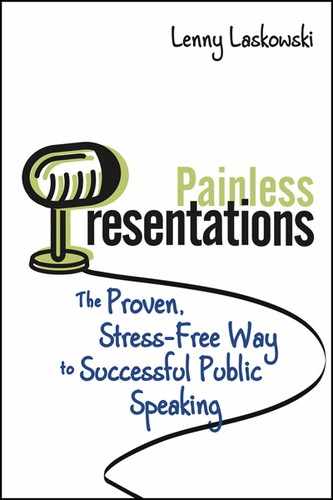Index
A
acronyms, motivational
Allen, Steve
anxiety. See speaking anxiety
apologies, avoiding
appearance, importance of
ASCAP
attentiveness, audience
Audience
audio visual requirements
auditory (aural) communication channels
auditory (aural) learning
B
body, of presentations
body language. See nonverbal communication
body movement
bridge words
Briggs, Katherine Cooks
C
calls to action
Carson, Johnny
catalogs
chair arrangements
chalkboards
Channel, as presentation aspect
charts, pictorial
classroom style layouts
closings. See conclusions
comfort zones and levels
communication channels
complete texts, reading from
compound question tactic
computer LCD projectors
conclusions, presentation
confidence
conversational mode
credibility
customized program surveys
D
Dale, Edgar (Dale’s Cone of Experience)
delayed personal rewards
delay tactic
Deliver, delivery
descriptive gestures
diagrams
diffusion tactic
dinner style room layouts
direct appeal closings
direct personal rewards
distractions. See Noise
door locations
Dozen Deadly Dangers
E
Eckman, Paul
effective speech, tips for
emphatic gestures
encyclopedias
experienced speakers
eye contact
F
Facial Action Coding System (FACS)
facial expressions
fear. See speaking anxiety
Feedback
fidgeting, avoiding
fig leaf hand position
Flip cameras
flip charts
follow-up, importance of
food and refreshments
foreign languages
formal vs. informal settings
frowning
G
gestures
grabbers, closing
grabbers, opening
graphs
H
hand gestures
handouts
heart rates, anxiety and
high-anxiety speakers
hostility, diffusing
humor, using
I
immediate personal rewards
indirect personal rewards
informal vs. formal settings
information gathering
information overload
insensitive speakers
I.N.S.P.I.R.E. acronym
Internet, as research tool
interpersonal learning
intrapersonal learning
introductions
J
jokes and humor
K
kinesthetic learning
L
lateral movement
LCD projectors
learning styles
lecterns, hiding behind
lecture style room layouts
librarians
library and Internet tools
lighting
linguistic learning
listening skills
logical learning
look ahead closings
M
mathematical learning
Mehrabian, Albert
memorization
Message
mistakes, avoiding
Monroe, Alan H. (Monroe’s motivated sequence)
motivation
movies. See videos and movies
music
Myers, Isabel Briggs
Myers-Briggs Type Indicator
N
names, remembering
natural comfort zones
negative attitudes, avoiding
nervous speakers. See speaking anxiety
newspapers
nine Ps
Noise
nondescript hand position
nonverbal communication
Nonverbal Communication (Mehrabian)
notes, referring to
O
objectives, message
objects, pictorial
openings. See introductions
opera singer hand position
Organize, organized
overhead transparencies
P
passion, speaking with
pauses
PEP formula (point, example, point)
performance anxiety. See speaking anxiety
performance mode
periodicals
personal experiences
personal rewards
persuasive presentation
photographs
physical behaviors. See body movement; gestures; nonverbal communication
physical learning
pictorial communication channels
point-by-point transitions
poor presentations, reasons for
positive attitudes
posters
posture
PowerPoint
practice and improvement
prayer hand position
preparation
pre-program surveys
presentation delivery
presentation environment. See settings
presentation material and content. See Message
presentations, aspects of
presentation structure
“professional speakers” type
prompting gestures
punctuality
purpose, presentation
Q
question-and-answer periods
questions, as transitions
quotations, using
R
reference works, for research
refreshments and food
relaxation techniques
research. See information gathering
resting hand position
retention, of presentation material
reversed fig leaf hand position
rhetorical questions
room location and size layouts
room temperature
S
scripts
seating arrangements
self-confidence. See confidence
Setting
Silent Messages (Mehrabian)
sincerity
Smeadly, Ralph C.
social learning
solitary learning
spacial learning
Speaker
speaking anxiety
speaking styles
spider hand position
stage fright. See speaking anxiety
standing and position
steeple hand position
Steve Allen Show
stories, as transitions
structure and format. See presentation structure
suggestive gestures
summary closings
SurveyMonkey
surveys
T
table arrangements
team presentations
temperature, room
theater style room layouts
time limits, presentation
Toastmasters International
topic selection
transitions
transparencies
trigger transitions
trust. See credibility
Twain, Mark
U
u-shaped room layouts
V
verbal learning
videos and movies
visual aids
visual distractions
visual feedback, monitoring
visualization techniques
visual learning
voice and tone
W
walking patterns
warm-up routines
whiteboards
window locations
Z
Ziglar, Zig
